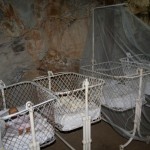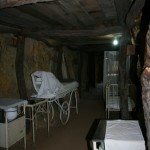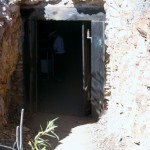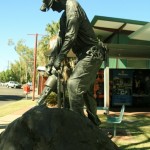Mount Isa (Wikipedia) is a city in the Gulf Country region of Queensland, Australia. It came into existence because of the vast mineral deposits found in the area. Mount Isa Mines (MIM) is one of the most productive single mines in world history, based on combined production of lead, silver, copper and zinc.
With a population of 21,992 recorded at the 2011 census and 33,200 in the surrounding district, Mount Isa is the administrative, commercial and industrial centre for the state’s vast north-western region. Although situated in an arid area, the artificial Lake Moondarra 19 kilometres (12 mi) north of the city on the Leichhardt River provides both drinking water and an area for watersports, birdwatching and recreation. Locals often refer to Mount Isa as “The Isa”.
- The land around the present day city of Mount Isa was home to the Kalkadoon aboriginal tribe. The Kalkadoon tribe led a subsistence lifestyle on this land that the white settlers looked at as nothing but poor grazing land, with the odd mineral deposit. As settlers and prospectors pressed further into their lands the Kalkadoon tribe members set out on one of Australia’s most successful guerrilla wars in a fight for their lands. Their success continued until at Battle Mountain in 1884, with what some historians have called a rush of blood, the tribe attacked a fortified position in large numbers and suffered terrible losses. The weakened state of the tribe made their land more vulnerable to the settlers and soon much of the land was lost. Armed patrols chasing the surviving tribe members and poor grazing lands for the settlers made times hard in the area over the following decades.
It is said that a lone prospector, John Campbell Miles, stumbled upon one of the world’s richest deposits of copper, silver and zinc during his 1923 expedition into the Northern Territory, but many people do not know that he was taken to the deposits by a young aboriginal man by the name of Kabalulumana (for whom an Indigenous person’s hostel in Mt. Isa is named). When Miles inspected the yellow-black rocks in a nearby outcrop reminded him of the ore found in the Broken Hill mine that he had once worked at. Upon inspection these rocks were weighty and heavily mineralised. A sample sent away to the assayer in Cloncurry confirmed their value. Miles and four farmers staked out the first claims in the area. Taken with friend’s stories of the Mount Ida gold mines in Western Australia, Miles decided upon Mount Isa as the name for his new claim.
Mount Isa Post Office opened on 1 August 1924. location for the town’s hospital was chosen in 1929, with a small building completed the following year. In 1931, a larger structure was moved to the site from the closed mining town of Kuridala.
In 2008 a Queensland Health report found that more than 10% of children in Mount Isa had blood lead levels above World Health Organization recommendations. The mining operator Xstrata denied responsibility and stated that the town has naturally high levels of lead in the soil.
Attractions include the Hard Times Mine at “Outback at Isa” and The Mount Isa Rodeo and Mardi Gras (held on the same weekend) has given Mount Isa the title of “Rodeo Capital of Australia”. The occasion may well triple the city’s population in these few days A memorial has been made especially for the Rodeo, down Rodeo Drive; the sidewalks have special memorials embedded in the cement.
The burial place of John Campbell Miles, the founder of Mount Isa, on the corner of Rodeo Drive and Miles Street. His ashes are buried underneath a large statue where each panel represents a significant part of Mount Isa. Miles’ ashes used to be watched over by a large clock where the statue now stands.
The World War II-era Mount Isa Underground Hospital is an historical building that has been registered on the Register of the National Estate and the Queensland Heritage Register. An air-raid shelter which could function as a hospital was a precautionary measure taken after Darwin was bombed in 1942. Local miners excavated the site which remains today as the only underground health facility in Queensland which was built during World War II.
The Xstrata Mount Isa Lake Moondarra Fishing Classic is held annually, and after 2011 will also be followed by a Fishing, Camping and 4×4 Expo. The Fishing classic is the richest fresh water fishing event in Queensland. Catching the tagged Barramundi fetches the greatest prize money.
Climate
Mount Isa experiences a hot semi-arid climate (Köppen climate classification BSh). The summer season is very hot with highly variable rainfall and humidity owing to the erratic influence of the monsoon. This can be almost non-existent in years like 1951/1952, where the only rain is from the occasional shower, or extremely intense as in 1973/1974 or 1999/2000, when as much as 1 metre (39 in) of rain may fall between November and March.
The “winter” season is very warm and almost completely dry with median monthly rainfalls from April to September below 2 millimetres (0.08 in), though nights can be quite cool and about once every two years a minimum below 0 °C (32 °F) has occurred. The lowest temperature recorded at Mount Isa is −2.9 °C (26.8 °F) on 7 July 1984 and the hottest is 45.9 °C (114.6 °F) on 29 January 1990.
1st July Tuesday
Another chilly morning. We were up early as we wanted to leave at 7, which is day break. We don’t like travelling in the dark because of Roos, cattle etc. I got dressed in bed (because it was cold, I put all my clothes next to the bed before we went to bed last night, wise move) while Ralph made the coffee and tea. Some of the road to Avon Downs looks good but it’s not really, it’s full of dips and it feels like we are on a bucking bull in a rodeo, there are warning signs for the cross winds, which this morning were very noticeable and towing a caravan, it made the trip a lot slower (not that we are in a hurry). The landscape is very much like desert, not much vegetation and the colour is a burnt yellow everywhere. The road was quite apart from the odd road train (which kept blowing our side mirrors in) and caravans. We stopped off at Barkly Homestead for a leg stretch and toilet break. We then set off for Avon Downs which is a 24 hour stop over, these places are great for when you have long distances to travel, it gives you that break and somewhere to camp. Avon Downs is unreal, a police station (and a huge one), a 24 hour camp spot and that’s it. No pub, no hotel, no nothing, in fact it’s not even in the middle of nowhere, it is just, ‘nowhere’. We have no idea why there is such a big police station here…… it’s bizarre. The wind is whistling through the few little low trees we have, there is nothing around us and we expect the tumble weed to come tumbling through the campsite, such is this place. The bird life is minimal. It’s a big 24 hour stop (it would probably fit about 40 caravans and there are only 5 here and it’s getting quite late…… WHY, I wonder????? (It’s not such a bad place). We haven’t had telephone or Internet connection now for about 4 days so you will all be bombarded with the update of the blog when we reach Mount Isa. We won’t get murdered in our bed tonight seeing as the police station is just across the road (ha, ha).
2nd July Wednesday
Hello! We are back in the land of Internet. Well, what a night last night! We had fire works, awesome stars that looked like they were raining on us all for free. Yesterday was Territory day and a local farm somewhere was letting off a firework display big time. We could see it from where we were camping. I think, that last night was probably one of the most awesome nights we have had. Camping in nowhere (free), fireworks (free), Stars (free), my old fella next to me in bed snuggled up, watching a James Bond movie with a cuppa and chocolates (free), Hugo, happy and warm on his bed (free)…….. what more could we want? We took off about 8 because we will be in Queensland today. We crossed the border into Queensland and stopped at Camooweal for a top up of diesel and a leg stretch. It’s quite an old place with most of it boarded up and not used anymore. We started have car problems just after there as we had a warning light come on which indicated that we had water in our fuel line. The poor old Nissan was struggling and we had 180kms to Mount Isa. We weren’t sure that we were going to make it and we had no signal on our phone. Well! We did eventually make it to the caravan park and have called a service centre and will take the car in tomorrow morning. Talking to a few people in the park, they have said that the fuel in Camooweal is a bit suss and we are not the first ones that this has happened to. Mount Isa looks pretty good. There’s traffic lights here (lots of them), we haven’t seen any traffic lights for quite a while and have forgotton what they are for. It’s a mining town and there is quite a bit to see around here. Sadly, we are only here for a day and because we have car problems, we won’t get to see all we want to see as we want to make sure that we get to Port Douglas before Margrit goes back to Germany. The caravan park is very cosy, we are all parked on top of each other. Thankfully we bought front and side screens so that we get a bit of privacy.
- The police station across the road from our freebie camp site in nowhere
- The police station across the road from our freebie camp site in nowhere
- Our freebie camp site
- A little bird in nowhere
- Sunrise in nowhere
- Welcome to Queensland
- Camooweal
- Camooweal
- Camooweal
- The pub in Camooweal and we are in Queensland where they don’t know how to spell beer 🙂
3rd July Thursday
All’s well that ends well. The car wasn’t as bad as we thought, the fuel filter was dirty (could be dirty fuel, we don’t know, but it did happen ½ hour after we filled up??). Never mind, it’s all fixed now. Poor Ralph had to spend some time at the shops as he waited 4 ½ hours and we all know how much Ralph loves shopping. He found himself a Bunnings and we did need some extra bits and pieces because the outlet hose connection broke and wherever we go the hose fittings are a different size, so he stocked up on all that stuff. He bought an in line filter, a bird book, a charger for my phone (this is what happens when he has too much time on his hands). He collected the car came back and did some running repairs. We then went to the underground hospital (Ralph waited with Hugo while I went in) which was hand dug during the war because of the bombing of Darwin, Broome and Kathrine. It was never used because Mount Isa was too far inland for the Japanese, it’s a fascinating museum never the less. We then went to the lookout and did some grocery shopping as we leave for Cloncurry in the morning. When we got back Ralph went to the office to swap some books and when he got back the blokes in the 2 caravans next door were checking his repair work. The ladies were in their caravans cooking up their concoctions. I think that it’s a cooking competition in some of these places because you can hear them say “and, what are you cooking tonight?” and then Doris will say “I’m cooking such and such and I’m doing it this way”, and so it goes on. We had already eaten and because we have the screens up they don’t ask me. Had they asked me tonight I would have told them that I made rubbery crumbed steak and left over Casserole which is exactly what we had. They are all nice people and all mean well really. I’m hoping that we have internet in Cloncurry. It’s not a long haul tomorrow, only 120kms. We have already clocked up 8000kms, can you believe that? Until Cloncurry xxxxxxxxxx
- Underground hospital
- Underground hospital
- Underground hospital
- Underground hospital
- Underground hospital
- Underground hospital
- Opening to the hospital
- Opening to the hospital (there are 3 tunnels)
- Nurses tent
- View of Mount Isa
- View of Mount Isa overlooking one of the mines
- Statue outside of the Information centre
- Like I said, COSY 🙂
- very cosy




























Good to hear from you again – your “free” night sounded awesome – bugger about the car problems – sounds lime dodgey fuel supplies. Glad Hugie is doing well. I love how you write your blogs – feel like I’m travelling with you
WoW! 8000 kilometres! talk about seeing Oz good to hear from you. Quite a long haul to Port Douglasstill!
Love
Hi Linda and Ralph.
Glad to see that you are still going strong. Fascinating descriptions. What an adventure.
Glad that you can do it.
Lots of love, Mom
Hi Linda and Ralph.
Will you be able to keep this blog after your trip is over?
I don’t know Mom, I will have to ask the Guru aka ‘Richard’ xxxx